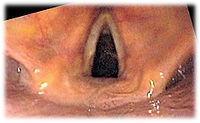
Photo from wikipedia
We thank Drs Hansel and Rogers for their comments regarding our work [1]. The authors raise concerns regarding our results for percentage of glottic opening and time for intubation [2].… Click to show full abstract
We thank Drs Hansel and Rogers for their comments regarding our work [1]. The authors raise concerns regarding our results for percentage of glottic opening and time for intubation [2]. Although we agree that there were high values of the I statistics, we respectfully disagree that we should not have presented summarised results from meta-analyses based uniquely on such measures. A discussion regarding heterogeneity as well as its reporting and interpretation seems to go beyond the I [3, 4]. As stated in the Cochrane Handbook, “Thresholds for the interpretation of the I statistic can be misleading, since the importance of inconsistency depends on several factors” [3]. We, therefore, consider that the scenarios should be evaluated on a case-by-case basis. While in some instances summarised results from heterogeneous studies may be misleading, in others they may enable us to look at the bigger picture, the average comparative performance from a range of possible results [4]. In our study, we chose to present the pooled effects and the heterogeneity measures, together with the 95%CIs and the total range of mean differences so that readers could better understand how the results varied across the studies, as well as whether their variability would affect the inferences and conclusions. The authors also question the way we clustered the available devices. We agree with their concerns and listed this as a possible limitation of our study. We also discussed at the planning stage whether we should group the laryngoscopes as outlined by the authors: Macintosh-style; hyperangulated; and channelled. However, we did not find evidence supporting any specific clustering of the devices. We could find no evidence supporting equivalence among the hyperangulated or Macintosh-style videolaryngoscopes for intubation performance. On the contrary, in the studies included in the networkmeta-analyses of Singleton et al. [5], the C-MAC D-Blade had a performance for first-pass success closer to the McGrath and the C-MAC than the GlideScope . Our own results counter the assumption that all hyperangulated blades might function similarly as we found different performances among the different hyperangulated devices, including a statistically significant difference for the AP Advances difficult airway blade videolaryngoscope, for first-pass success. Therefore, we considered that even similarly angulated blades from different manufacturers have differences in their designs and functionalities that might influence their ergonomics, tendency to fog, quality of image, angle of view, etc., all possibly influencing their performance. The authors also discuss the similarities between two hyperangulated videolaryngoscopes, the C-MAC D-Blade and the GlideScope, and state that the lack of statistically significant differences between them came as no surprise. We should be mindful that absence of evidence is not evidence of absence. No significant difference or equivalence can be reliably inferred from our results for these two devices. In fact, the C-MAC D-Blade performed better than the GlideScope in our set of included studies, although not reaching statistical significance for six out of the seven evaluated outcomes. Lastly, the uncertainties related to our analyses are mentioned throughout the manuscript, including the summary and discussion sections. We acknowledge that our study has limitations and endorse the need for prudence when considering the rankings. However, we would like to stress that we were as transparent as we could be throughout the review; none of the authors have any conflict of interest; the study was performed according to a previously registered and published protocol; the analytical code and our datasets were also made available for checking; and for the sake of academic integrity, we reported what we planned and did not omit results based on our findings.
Journal Title: Anaesthesia
Year Published: 2022
Link to full text (if available)
Share on Social Media: Sign Up to like & get
recommendations!